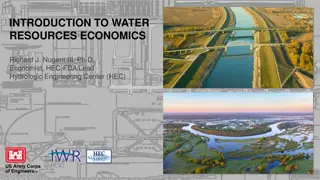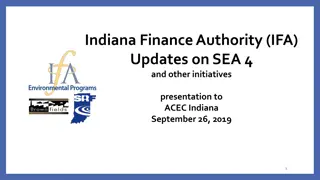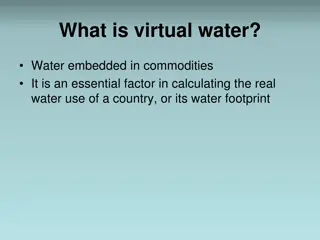Understanding Water Resources Economics
This resource introduces the principles of water resources economics, focusing on decision-making, cost-benefit analysis, and the role of economics in flood risk management and national development. It discusses how economics influences individual and government decisions in managing limited resources efficiently.
Download Presentation

Please find below an Image/Link to download the presentation.
The content on the website is provided AS IS for your information and personal use only. It may not be sold, licensed, or shared on other websites without obtaining consent from the author. Download presentation by click this link. If you encounter any issues during the download, it is possible that the publisher has removed the file from their server.
E N D
Presentation Transcript
INTRODUCTION TO WATER RESOURCES ECONOMICS Richard J. Nugent III, Ph.D. Economist, HEC-FDA Lead Hydrologic Engineering Center (HEC)
2 OUTLINE 1. Introduction to Economics 2. Public Economics Perspective 3. Flood Control Act of 1936 4. 1983 Principles and Guidelines 5. Role of Economics Summary 6. Cost-Benefit Analysis 7. Optimization
3 INTRODUCTION TO ECONOMICS Economics is the science of decision-making: the study of the allocation of scarce resources. 1. How do people make decisions? 2. What are the optimal decisions? 3. Why do (1) and (2) not match?
4 INTRODUCTION TO ECONOMICS Economics helps individuals, households, organizations, and governments make better decisions. Perspective of consumer: unlimited wants, but not unlimited funds! Economics: what combination of goods and services, spending and saving (debt), work and leisure makes us the best off? Perspective of government: unlimited interests, but not an unlimited budget! Economics: what combination of programs and infrastructure, spending and debt (saving) makes the country the best off?
5 PUBLIC ECONOMICS PERSPECTIVE Why is the federal government in the business of flood risk management? Market Failure Due to: Economies of Scale Excludability
6 FLOOD CONTROL ACT OF 1936 Flood control on navigable waters and their tributaries is in the interest of the general public welfare Federal government may participate in flood control if the benefits to whomsoever they may accrue are in excess of the estimated costs, and if the lives and social security of people are otherwise adversely affected. thanks for the job security!!
7 PRINCIPLES AND GUIDELINES (P&G 1983) Federal Objective: Contribute to national economic development consistent with protecting the Nation s environment NED Benefits: Increases in net value of the national output of goods and services NED Plan: A plan that reasonably maximizes net national economic development benefits, consistent with the Federal Objective
8 ROLE OF ECONOMICS: SUMMARY The role of economics in FRM involves: 1. Assess (potential reductions in) flood risk 2. Weigh the trade-offs: reduction in flood risk against the cost of reducing flood risk 3. Maximize increases in net national economic value while protecting the nation s environment National economic value is measured in terms of national economic development (NED) benefits: 1. Flood risk reduction 2. Emergency and clean-up cost savings 3. Advanced bridge replacement (cost savings) Flood risk reduction is identified through counterfactual analysis. Benefits are identified as difference in damages between two states of the future: with- and without-project conditions
9 NED BENEFITS Without-project flood damage -- With-project flood damage
10 NED COSTS Project first cost Interest during construction Operations and maintenance
11 11 TRANSFORM COSTS AND BENEFITS INTO AVERAGE ANNUAL EQUIVALENT (AAEQ) TERMS Amortize over 50-year Period of Analysis Construction Period Period of Analysis 2025 2020 2075 (Base Year) Costs Compounded Forward to Base Year Costs and Benefits Discounted Back to Base Year
12 NED NET BENEFITS AAEQ Benefits -- AAEQ Costs AAEQ Benefits AAEQ Costs Benefit-to-Cost Ratio AAEQ Net Benefits The plan with the highest net benefits is the NED plan The NED plan should have a BCR above 1 to be considered economically justified
13 IN PRACTICE: IDENTIFY NED PLAN
14 FINAL NOTE: OPTIMIZATION























